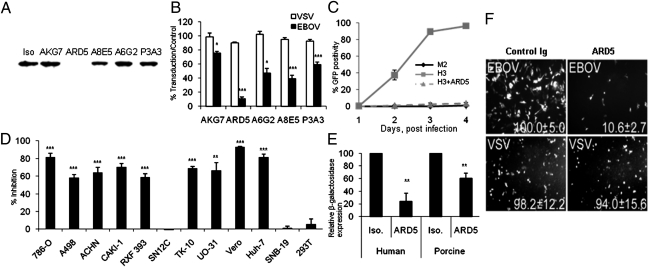Fig. 4.
TIM-1 mAb ARD5 inhibits EBOV entry. (A) Ability of anti–TIM-1 monoclonal antibodies to block EBOV pseudovirion binding to Vero cells. Cells were incubated with indicated mAb and then incubated with EBOV GP ΔO pseudotyped FIV for an additional hour at 4 °C. Lysates were probed for FIV capsid by immunolotting and normalized for β-actin expression. (B) Ability of five anti-human TIM-1 monoclonal antibodies to block EBOV GP transduction. 786-O cells (renal cell line 4 in the NCI-60 panel; Fig. 1C) were preincubated for 1 h at 4 °C with monoclonal antibodies against the ectodomain of human TIM-1. Cells were shifted to 37 °C and transduced with VSV pseudotyped with either EBOV GP ΔO or VSV G (MOI= 0.01). (C) ARD5 inhibits recombinant, infectious EBOV GP VSV infection of H3 cells. M2 (TIM-1−) or H3 (TIM-1+) HEK 293T cells were plated and H3 cells preincubated with ARD5. Cells were then infected with EBOV GP VSV (MOI = 25 as assessed in Vero cells). (D) Ability of ARD5 to inhibit EBOV GP-dependent transduction of permissive cell lines. Equal numbers of each cell line were preincubated with ARD5 for 1 h at 4 °C. Cells were shifted to 37 °C and transduced with VSV pseudotyped with EBOV GP ΔO (MOI = 0.05). Findings are shown as percent inhibition compared with isotype control populations. (E) ARD5 inhibits EBOV GP-mediated entry into well-differentiated human and porcine airway epithelial cultures. Cells were incubated with ARD5 or isotype control and then transduced with EBOV GP ΔO pseudotyped FIV at an MOI of 5. (F) ARD5 treatment inhibits EBOV infection. Vero cells were treated for 30 min with ARD5 or isotype control and then challenged with either a replication-competent EBOV or VSV that express eGFP upon infection. *P < 0.05, **P < 0.001, ***P < 0.0001.

